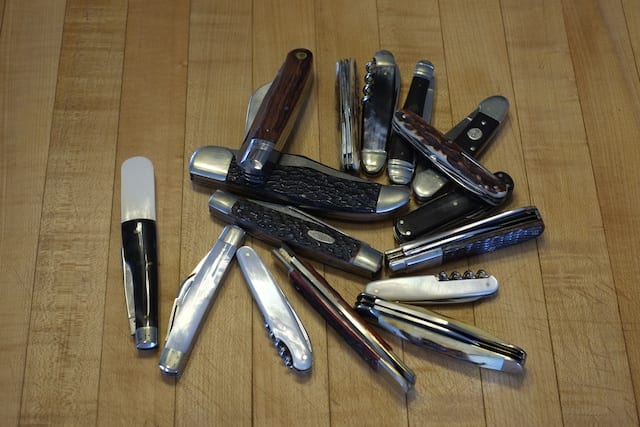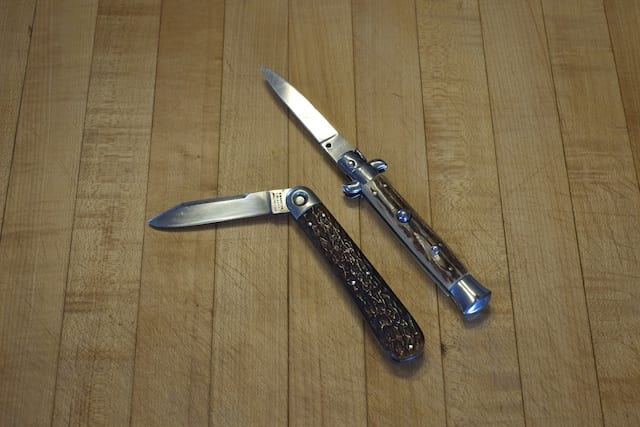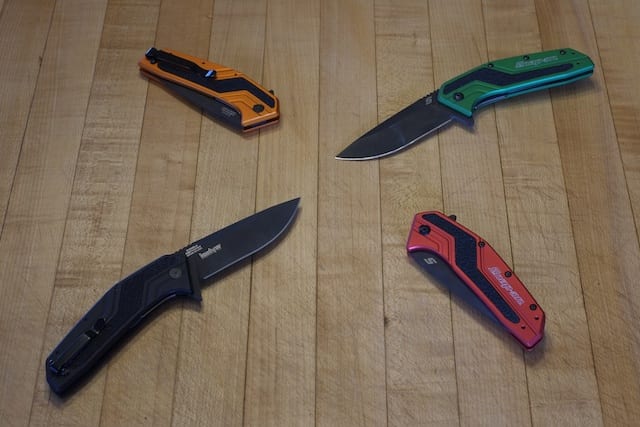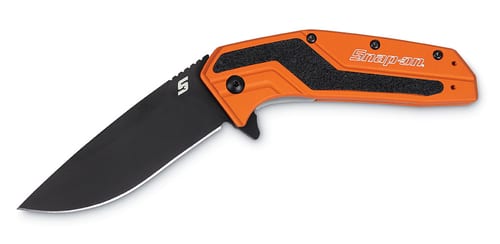I have been testing the new Snap-on Dash Pocket Knife for the last few weeks. Made in the USA in cooperation with Kershaw Knife, the Dash is a tour-de-force of ergonomics and utility. It touts made in the USA, high quality materials and Speed Safe® spring assisted opening technology. Closed it is 4 5/8″ long, opening to 8″ with a 3 1/2″ drop point blade.

Switchblades and Spring Assisted Deployment
I have been a knife affascinato since about age 8 when I would accompany my father on visits to Mitchell’s Hardware Store in East Orwell, Ohio. While he picked up what he needed for the latest home repair project I would admire the knives in a wood display case at the counter. In the 1950s all hardwares sold switchblades. Of course, a switchblade was what I really, really coveted; however, my father would say, “you are not old enough for a switchblade.” What my father was really saying was that I was not old enough for a knife. I had to wait until age 11 when I joined Scouts, eared a totin chip patch (license for a scout to use axes and knifes) and obtained a Scout three blade Whittling Knife made by Camillus.
Why I wanted a switchblade was that all the “racks” had one, cached in a pocket on the side of the engineer’s boots they wore as part of their dress code. The racks are personified today by Fonzy, but believe me they were not the bucolic font of wisdom portrayed by Henry Winkler in Happy Days. The racks were not very bright and beat the hell out of you on the playground if they caught you. Looking into that display case I thought, “If I just had one of those I would teach those thugs a thing of two.” Looking back all those years, my father’s sagacity in not letting me have one makes me thankful!

Because of the racks a Federal Law was passed in 1958 banning the import or position of switchblades in interstate commerce. Whether this lessened gang violence or the toughs simply turned to bats and guns is a discussion I will leave to the sociologists. The fact is, however, it denied the general population a knife that is highly useful for a variety of reasons. A switchblade can be opened with one hand if the other is occupied. It is compact and fits in a pocket with the blade safely covered. For these two reasons they were issued to paratroopers in WWII. You couldn’t accidentally slice a shroud line with the Knife, Pocket M2, but your could cut yourself out of the shrouds with one hand while your other was usefully occupied: firing a gun, hanging onto a tree branch, etc. All this said, the overpowering reason I like them so much is that they are just plain fun!
One drawback to a switchblade is that without an additional locking mechanism the blade is prone to accidentally opening. If this happens in your pocket damaged clothing is the best you can hope for. For this reason most switch blades, including the M2, have a safety lock that must be moved before the opening button is operable. Because the 1958 law only applies to interstate commerce it is possible to still buy switch blades in some states. Oddly the law did not ban spring assisted knives which require some physical effort to start the opening process. Most spring assisted knives have a horn, which is called a flipper in the patent abstract, that extends from the base of the blade up through the back. Rearward pressure on the horn starts the opening process and the blade snaps open providing your fingers or other things are not in the way.
Snap-on Dash: What They Say
Cutting to the chase, the Snap-on Dash is such a spring assisted knife; probably the best I have ever had the pleasure of opening. Advertising claims for the Dash are:
- Equipped with a big, slightly drop-pointed blade that offers both excellent slicing and piercing capabilities
- High-performance stainless blade steel offers excellent corrosion resistance and enhanced looks
- Lightweight machined 6061-T6 anodized aluminum handles, with Trac-Tec inserts, ensure extremely solid grip
- Equipped with SpeedSafe® knife assisted opening technology
- A short push on the index point overcomes the resistance built into the torsion bar in the mechanism
- SpeedSafe knife technology takes over and the blade moves out of the handle quickly and easily
- Inset Liner Lock® mechanism – an inset steel plate functions like a locking liner, in one side of the handle
- Upon blade deployment, the steel plate moves behind the blade securely locking it open without all the weight and bulk of full liners
- Includes reversible deep carry pocket clip so the knife can sit all the way down in the pocket
Snap-on Dash: What We Say
The drop point blade is indeed a utilitarian, general purpose shape that is good for anything from slicing salami and brie at an impromptu picnic, to removing the remains for a gasket from an engine block. The high performance stainless steel is Sandvik’s 1428N alloy, which has the right stuff to be a very good blade. With a carbon content of 0.62% it can be heat treated up to about HRC 62 with no difficulty. With 14% chrome and 0.11% nickel it should have excellent corrosion resistance. Additionally, the blade has a diamond like coating (DLC) that is both flexible and diamond hard. I think it will take a couple of years to say if it is beneficial or not?
The side plates (scales) are made form 6061, a very good free machining aluminum alloy with a T6 temper, which is the hardest aluminum can be rolled to. Anodizing allows corrosion resistance as well as the four colors: black, green, orange and red. I would like to see hard coat anodizing which offers a much higher level of protection and wear resistance than standard anodizing does. The black Trac-Tec appears to be a textured polymer that offers good gripping properties even when wet.
The SpeedSafe® opening is stupendous. Slight rearward pressure on the horn/flipper, which Snap-on/Kershaw now calls the index point, starts the opening process. At approximately 25° of movement the spring takes over and the blade snaps to full extension, locking open in the process. After removal from the box I deployed the blade two-dozen times in sheer amazement at its flawless deployment. The opening is flawless no matter what position you start the process in. Up, down, sidewise, it doesn’t matter. I even got the knife really dirty cutting asparagus and it still opened just fine. I pushed it into mud to just shy of the clip and it still opened. In simultaneously carrying two to three of them over the past few weeks not one even offered to open accidentally. Kudos Kershaw. If you wand to more detail you can go to Google Patent Search and read the patent abstract. The patent is US 8001693 B2 Closable knife with opening mechanism.
Finally, the clip works as advertised. It is reservable allowing the the knife to be clipped out of site, but available, in your left or right pocket depending on your handedness. As delivered the blade was nicely sharpened to a medium grind for general purpose cutting of food, rope and small game. The edge was completely free of feather (burr). Working knives should be sharpened on a medium stone. When the length of the edge is drawn over fibrous substances such as rope the slight serrations left by a medium grind severs the fibers quickly. Bringing the edge to a polish on a fine or extra fine stone will cause a knife to slide rather than cut hemp rope. If you want to push the edge directly forward in tasks such as whittling/carving then the polished edge yields much better results. I give the Snap-on Dash Knife my unqualified recommendation.
For the latest previews, reviews, and news, make Pro Tool Reviews your home page or follow us on Facebook and Twitter!



